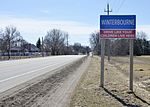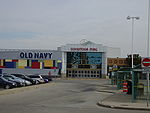Conestogo River

The Conestogo River is a river in Waterloo Region and Wellington County in Southwestern Ontario, Canada. The river was named by Mennonite settlers after the Conestoga River in Pennsylvania. In the 1800s there were several different spellings of the name of the river and of the nearby settlement of Conestogo, Ontario but the name ending in "o" became official.It is in the Lake Erie Basin and joins the Grand River as a right tributary at the community of Conestogo. A dam built on the river for flood control formed Conestogo Lake, which covers an area of about 23 square kilometres (8.9 sq mi). A conservation area operated by the Grand River Conservation Authority is located on this lake.
Excerpt from the Wikipedia article Conestogo River (License: CC BY-SA 3.0, Authors, Images).Conestogo River
Sawmill Road, Woolwich
Geographical coordinates (GPS) Address Nearby Places Show on map
Geographical coordinates (GPS)
| Latitude | Longitude |
|---|---|
| N 43.538333333333 ° | E -80.486388888889 ° |
Address
Sawmill Road
Sawmill Road
N0B 1N0 Woolwich
Ontario, Canada
Open on Google Maps






